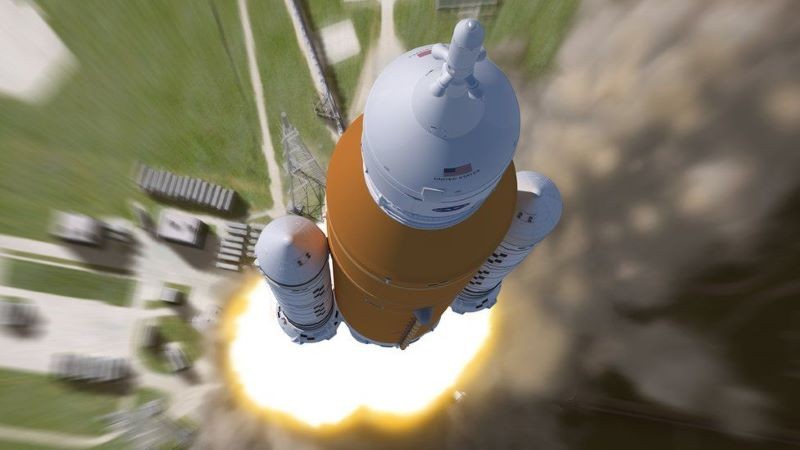It’s official—NASA has once again delayed plans to launch the Space Launch System rocket, a move that shouldn’t come as much of a surprise if you’ve been paying attention. But there is a date within sight: the towering rocket stack that marks the first moon rocket NASA has constructed since the Apollo days is slated for an unmanned test launch in February 2022.
While this is a step in the right direction for NASA’s lunar program—the plan is to send astronauts back to the moon to establish a sustainable long-term presence there and then ultimately to get boots on Mars in the 2030s—the launch was previously set for this November. Now it remains to be seen if NASA will make its newest target window, with the first opportunity for actually sending the rocket coming on February 12.
Whenever it does happen though, the mission, Artemis 1, will see the launching of the towering SLS—which comes in at about 321 feet tall with the Orion spacecraft on top of it—sending the largest and most powerful rocket ever created into the atmosphere, producing a staggering 8.8 million pounds of thrust. From there, the plan is to send the spacecraft in a loop around the moon to complete the first mission. If all goes smoothly, 2023 will see the first crewed lunar loop of Orion and the SLS with Artemis 2, followed by Artemis 3, an actual moon landing. Or at least that’s the plan.
First created to assuage outraged lawmakers after President Obama canceled the Constellation program back in 2010, building the SLS was offered up to help fill in the enormous gap the President George W. Bush-era program’s cancelation left for workers whose jobs revolve around human spaceflight in Alabama, Louisiana, Arkansas, Florida, and, of course, here in Texas.
But the project, which was originally supposed to have its first launch in 2016, has had countless delays. Back in 2017 NASA even acknowledged that the federal Government Accountability Office was correct when it had urged the space agency to notify Congress that the original mandate to get the SLS launched by 2019 simply was not going to happen.
However, despite all of this, in 2019 then-President Donald Trump ordered that NASA pull off a moon landing by 2024. So right now, that is the current plan—technically, at least. Although that is still the official timeline, based on the delays that have already slowed up the process—including the first test firing of the SLS engines back in January, which ended prematurely when the engines shut down just over a minute after ignition—it will almost certainly take a bit longer than officially announced to pull off our first moon landing since 1972. But one thing we do know? At least one member of the Artemis 3 crew will be female, meaning that whenever the mission does finally take astronauts to the lunar surface it will mark the first time a woman steps foot on the moon.
Meanwhile, SpaceX is comfortably taking over hauling astronauts and supplies to the International Space Station. The next crewed Dragon launch, SpaceX’s third, will be toting four astronauts to the ISS and is slated to take place this Sunday at Cape Canaveral, just down the way from the spot where engineers are putting the finishing touches on the SLS.
Support Us
Houston's independent source of
local news and culture
account
- Welcome,
Insider - Login
- My Account
- My Newsletters
- Contribute
- Contact Us
Establishing a Base on the Moon is Going to Take a Little More Time

Photo illustration by NASA
Going, going, not gone quite yet.
[
{
"name": "Related Stories / Support Us Combo",
"component": "11591218",
"insertPoint": "4",
"requiredCountToDisplay": "4"
},{
"name": "Air - Billboard - Inline Content",
"component": "11591214",
"insertPoint": "2/3",
"requiredCountToDisplay": "7"
},{
"name": "R1 - Beta - Mobile Only",
"component": "12287027",
"insertPoint": "8",
"requiredCountToDisplay": "8"
},{
"name": "Air - MediumRectangle - Inline Content - Mobile Display Size 2",
"component": "11591215",
"insertPoint": "12",
"requiredCountToDisplay": "12"
},{
"name": "Air - MediumRectangle - Inline Content - Mobile Display Size 2",
"component": "11591215",
"insertPoint": "4th",
"startingPoint": "16",
"requiredCountToDisplay": "12"
}
]

